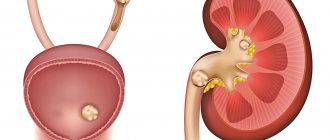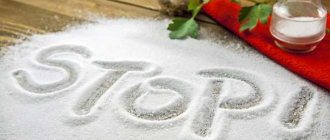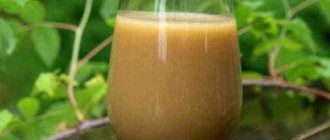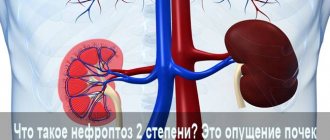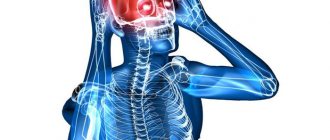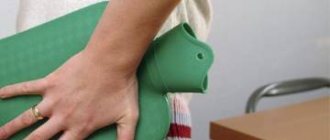Diet for kidney stones in men is one of the main therapeutic measures in addition to drug therapy and a special operation for crushing with shock wave equipment.
Nephrolithiasis (kidney disease) is triggered by various reasons: poor environmental situation, stress, poor diet, hard water, and excessive use of medications. All these factors provoke the appearance of kidney stones in men and the exacerbation of diseases. To dissolve stones, you need not only to use special medications and folk remedies at home, but also to reconsider your diet.
Why is it important to plan your diet correctly?
A person may be unaware of the existing disease for years until the first attack of renal colic occurs, characterized by the appearance of acute pain in the lumbar region. Renal colic is usually accompanied by nausea, vomiting and fever.
The main treatment for kidney stones is taking medications that dissolve the stones, or surgery to remove the stones. However, regardless of the choice of treatment tactics, proper nutrition is recommended for each patient. The treatment menu is compiled individually for each patient after determining the composition of the stones. Diet after removing kidney stones helps avoid exacerbation of the disease.
Every person suffering from kidney stones should know what can be eaten with certain stones, what foods must be completely excluded from the daily menu, and what rules must be followed when compiling a daily diet.
For oxalate stones
Doctors believe that the main reason for the formation of oxalate stones is insufficient fluid intake, which leads to severe dehydration. If you have been diagnosed with this, be sure to follow the recommended drinking regime.
An additional reason for the formation of oxalate stones can be considered a high content in the diet of foods with green, purple and red pigmentation. The special diet should include:
- Abundance of greenery;
- Sour berries, apples, citrus fruits;
- Beets, cucumbers and mushrooms;
- Chocolate and nuts;
- Coffee and tea.
You can create your own daily menu for a therapeutic diet using approved foods. For breakfast, it is better to eat fruits, oatmeal, juices, low-fat cottage cheese, and kefir. During lunch you can eat vegetable soups, fish or meat. For dinner, protein, fresh vegetable salads, and yogurt are recommended.
Why kidney stones form
There are two groups of factors that contribute to the formation of kidney stones. They can be both external and internal. External factors include the following:
- living in a hot climate zone (as studies have shown, residents of hot countries most often suffer from nephrolithiasis due to dehydration and increased urine concentration);
- unhealthy diet containing insufficient amounts of vitamins and nutrients;
- violation of the drinking regime (if you drink too little during the day, the concentration of urine increases, and as a result, salt deposition);
- sedentary lifestyle;
- long-term treatment with certain medications.
Internal factors include the following:
- congenital anomalies of the structure of the urinary system;
- diseases of the endocrine system, in particular hyperparathyroidism;
- pH imbalance in urine;
- inflammatory processes in the organs of the urinary system;
- impaired metabolism;
- gout;
- disturbance of urine outflow;
- diseases in which a person has to spend a long time in a stationary position, for example, strokes or injuries;
- diseases of the liver and gastrointestinal tract.
Urate kidney stones and causes of their appearance
The formation of urate stones in the kidneys is quite often a provoking factor in the development of various complications in other organs and systems of the human body. As a rule, uraturia occurs due to excessive accumulation of uric acid in the urinary organs, which, when decomposed, forms sand and small stones.
The production of uric acid is based on purine compounds, the source of which in the body are certain foods. It is worth noting that purines play an important role in the structure of DNA and proteins, but disruption of their metabolism often produces diseases such as urate kidney stones.
The main reasons for the formation of urate stones:
- violation of metabolic processes;
- low physical activity during the day;
- diseases of the digestive and genitourinary systems;
- abuse of spicy and sour foods;
- predisposition to this disease at the genetic level;
- disturbed water balance of the body. Excessive fluid loss can be caused by high fever, vomiting, and severe physical exertion;
- poor blood flow to the kidney.
The appearance of urate kidney stones can also be triggered by fasting or excessive consumption of foods that supply purine substances to the body, in particular:
- Protein-containing products: meat (especially fried), meat by-products and broths, legumes, mushrooms.
- Fish, including canned fish.
- Tomatoes.
- Alcoholic drinks.
- Chocolate.
It is important to know that the likelihood of urate kidney stones occurring is the same for both males and females. Moreover, this problem can be encountered at any age.
Types of stones
Stones formed in the kidneys are divided into several groups based on their chemical composition. These include:
- calcium, which include oxalate and phosphate stones;
- urate;
- mixed;
- protein;
- cystine;
- cholesterol
Most patients who go to the doctor with complaints of renal colic are found to have calcium and urate stones. The remaining species are formed quite rarely. Therefore, it is advisable to consider which diet helps improve the condition of patients with the first two types of stones.
Oxalate stones are formed due to deposits of calcium salts of oxalic acid. At the same time, the acid-base balance of urine does not change in people. A special feature of such stones is their insolubility. Therefore, the only treatment to remove the stone is surgery. They are formed due to excessive consumption of vegetables and fruits containing oxalic acid, for example, sorrel, spinach and citrus fruits.
Phosphate stones are formed as a result of deposits of calcium salts of phosphoric acid when the urine balance changes towards alkalization. Such stones dissolve under the influence of mineral water and fruit acids.
Urate stones are formed when the excretion of uric acid is impaired. And the main reason for their appearance is gout. They are formed in an acidic environment, dissolving under the action of alkalis.
Basic Rules
A diet for urolithiasis in the kidneys will primarily prevent the entry of stone-forming factors into the urinary tract, which will be an effective prevention of the formation of new or enlargement of existing stones.
The selection of products depends on the type of metabolic disorders. Only after a complete examination and clarification of the causative factors of the pathology can a therapeutic diet be compiled. The diet for urolithiasis has the following goals:
- reducing the severity of accumulation and formation of mineral and organic salts;
- reducing inflammatory changes with preventing the risk of exacerbation of kidney infection;
- ensuring low load on the functional activity of the kidneys.
It is important not only not to eat prohibited foods, but also to know exactly which food components will help cope with urolithiasis.
Purpose of diet therapy
As mentioned above, the doctor selects a treatment regimen for kidney stones based on the examination results. However, achieving lasting positive results is only possible if you adjust your diet for kidney stones.
For kidney stones, the diet sets the following goals:
- changing the diet helps improve purine metabolism and other metabolic processes;
- depending on the chemical composition of the stones, the diet allows you to change the balance of urine to the acidic or alkaline side;
- Proper nutrition helps normalize intestinal function and normalize weight.
We treat the liver
Warehouse relocation to Europe. We sell hepatitis C drugs in Russia at the purchase price - warehouse liquidation Go to website
Urolithiasis disease
Diet for kidney stones in men is one of the main therapeutic measures in addition to drug therapy and a special operation for crushing with shock wave equipment.
Nephrolithiasis (kidney disease) is triggered by various reasons: poor environmental situation, stress, poor diet, hard water, and excessive use of medications. All these factors provoke the appearance of kidney stones in men and the exacerbation of diseases. To dissolve stones, you need not only to use special medications and folk remedies at home, but also to reconsider your diet.
1
Basic nutrition rules
Comprehensive treatment for kidney stones includes a healthy lifestyle, including proper nutrition. To achieve sustainable results, the diet must be long-term. It is developed individually for each person, depending on the type of stones in the urine.
Diet in the presence of kidney stones will prevent their increase in size and the formation of new ones. In addition, appropriate nutrition will remove accumulated salts, improve the digestion process, and reduce the likelihood of inflammation in the urinary canals.
The basic rules of nutrition for kidney stones in men are as follows:
| Rules | Peculiarities |
| Diet | Eat food 5-6 times a day. Of these, 3 are main meals, and the rest are snacks. As a result, the interval between them will be approximately 3 hours. The last meal should be 3 hours before bedtime |
| Heat treatment of products | Any options are allowed, with the exception of frying in oil. It is best to replace such dishes with casseroles cooked in the oven. |
| Food temperature | The optimal option is from 15 to 600 C. In other words, you should not eat too hot or cold food |
| Limiting salt intake | Only 5 g per day is allowed. Excessive amounts cause an increase in stones and an increase in blood pressure. It is recommended to add salt immediately to prepared dishes. Then it is easier to keep track of the daily dose. It is best to replace table salt with sea salt |
| Limiting intake of foods high in ascorbic acid | In large quantities, this substance is harmful for kidney stones |
If you have kidney stones, you will have to avoid foods that contain large amounts of purines. This applies to foods high in animal proteins and saturated fatty acids.
For kidney stones the following are contraindicated:
- cookies, desserts with jam, preserves, creams, halva, baked goods;
- fatty meat and fish, caviar, seafood, sausage, smoked meats;
- jelly, coffee, cocoa;
- citrus;
- sour berries;
- greenery;
- egg yolk;
- salty cheeses with spices;
- legumes
Allowed foods include:
- whole wheat bread;
- porridge;
- pasta from durum wheat;
- chicken and turkey;
- lean fish (cod, pollock);
- fresh fruits and dried fruits;
- salads with pickled and sauerkraut;
- dairy products;
- mild cheeses;
- honey, pollen, marshmallow, marmalade.
It is recommended to consume more foods that have an alkalizing effect on urine and dissolve urate and oxalate stones. The menu should include fruits, vegetables, and low-fat dairy products containing bifidobacteria. The exception is phosphaturia, when it is necessary to create a special “acidic” environment.
It is recommended to consume more foods containing B vitamins, as they speed up the process of removing urate and oxalate stones. To enhance the effect, you need to introduce foods rich in vitamin A into your diet. It is not only beneficial for the whole body, but also restores the mucous layers of the kidneys and urinary tract.
How to get rid of kidney stones in men at home?
2
Menu for the week
When preparing a diet for 7 days, you need to take into account all the secrets of proper nutrition for nephrolithiasis and exacerbation of renal pathologies. It is recommended to develop the menu in advance.
An approximate diet for a week is presented in the table.
| Day of the week | Menu |
| Monday |
|
| Tuesday: |
|
| Wednesday |
|
| Thursday |
|
| Friday |
|
| Saturday | Fasting day. It is allowed to eat fruits from the list of permitted ones and cottage cheese. Drink water or green tea |
| Sunday |
|
You can wash down your meals with black and green tea, a decoction of rose hips, dried fruit compote, berry juice, and milk. Before going to bed, it is recommended to drink a cup of kefir or yogurt, low-fat natural yogurt without fruit and berry additives. Additionally, you are allowed to have a snack before going to bed, cereal bread or biscuits.
Why men get sand in their kidneys and how to treat it
3
Nutritional features for different types of stones
The diet may vary depending on the type of stones. There are general dietary rules that apply to any kidney stones, but there are also certain features indicated in the table:
| Type of stones | Reason for education and recommendations |
| Oxalates | They are common types of stones. This problem is caused by metabolic disorders with oxalic acid, which affects the formation of insoluble calcium salts in the urine. The main reason for their formation is dehydration. This is why it is important to monitor your drinking regime if you have oxalate stones - you need to drink 2-3 liters of clean or mineral water per day. Fruit drinks and compotes are suitable. The next reason that causes the abundant formation of oxalic acid in the internal organs is the consumption of large quantities of products of purple, dark green and red shades. It is recommended to eat more raspberries, blueberries, citrus fruits, mushrooms, cucumbers, apples and leafy greens |
| Urats | Formed due to uric acid salts. This disease is called uraturia. During treatment, you should not consume smoked foods, preserves, or alcohol. To prevent the formation of such stones, it is recommended to eat grapes, watermelons, green apples, and black currants. You definitely need to drink more clean water |
| Phosphates | The main factors that provoke the formation of phosphate stones are infections, acute renal failure, hydronephrosis, kidney shrinkage, and colic. It is necessary to limit the consumption of nuts, alcohol, hot spices, cheese, cereals with milk, sour cream, eggs, fresh fruits and vegetables, smoked meats, pickles |
Types of kidney stones in men: symptoms and treatment methods
4
Recipes
Be sure to monitor your drinking regime and drink up to 2 liters of water per day. Various decoctions and infusions based on medicinal plants are useful:
- burdock;
- rose hip;
- wheatgrass;
- knotweed;
- Birch buds.
Need 1 tbsp. l. pour a cup of boiling water over the raw materials and leave for a couple of hours. Drink a few sips half an hour before meals. You can add ginger to the drink.
It is useful to eat dark raisins. Recommended juices include carrot, beet, pumpkin, lemon, tomato, cucumber, and apple. Honey is added to drinks to taste.
The diet in question allows the consumption of dishes prepared according to the following recipes.
4.1
Carrot and pumpkin soup
Cooking method:
- 1. Boil 1 potato tuber and 500 g pumpkin.
- 2. Chop the carrots and onions and fry until they become soft.
- 3. Drain the water from the vegetables.
- 4. Mix all the vegetables and grind in a blender. Add water to adjust the thickness of the dish.
- 5. Add seasonings and simmer for 10 minutes.
4.2
Pilaf with dried fruits and pumpkin
The dish turns out sweet. To prepare it you need:
- 1. Peel 100 g of pumpkin and apples, cut into small pieces.
- 2. Wash and chop dried fruits (prunes, dried apricots, raisins).
- 3. Pour a little oil onto the bottom of the pan, then add apples and pumpkin, add 100 g of rice. Layer the same products again on top. Pour in the water in which the spices are mixed.
- 4. Boil for an hour.
4.3
Potato salad
Cooking method:
- 1. Boil 5 potato tubers in their skins, peel and cut into cubes.
- 2. Grind 2 cloves of garlic, add spices, 1 egg yolk and half a glass of sour cream.
- 3. Pour the resulting sauce over the potatoes.
Energy bars are suitable for sweets. To prepare them, you need to mix 1 cup of oatmeal, dried apricots, prunes, raisins, dried pieces of apples, flax seeds, sunflower seeds, pumpkin, sesame seeds, walnuts, banana and honey (proportions to taste, or in equal proportions). Mix everything and form bars from the resulting mass. Place on a baking sheet and place in the oven for 10 minutes.
Source: zdravman.com
We are in social networks:
Nutritional features during phosphate deposition
If phosphate stones are detected in the kidneys, the diet is aimed at increasing the acidity of the urine, since this type of stone dissolves in an acidic environment.
In this case, the following products are excluded from the daily menu:
- smoked and canned products;
- dairy products;
- eggs;
- wheat flour bread;
- vegetables;
- fresh fruits, excluding sour ones;
- hot spices and seasonings.
The following can be used without limitation:
- meat, fish and broths;
- fish caviar;
- vegetable and butter;
- cereals;
- pasta;
- mushrooms;
- sugar and other sweets;
- tea;
- watermelons.
For phosphate stones, it is useful to prepare a rosehip decoction. You can drink it instead of morning coffee or evening tea.
A sample menu looks like this:
- carrot salad with sugar, millet porridge, fruit juice;
- a piece of apple pie, berry jelly;
- vegetable stew, piece of boiled chicken, green tea;
- lazy dumplings seasoned with sour cream;
- boiled potatoes in their jackets, baked fish, vegetable salad with herbs.
What foods should not be eaten during pathologies of the paired organ?
A competent diet when stones appear is considered to be the optimal ratio of acceptable foods with certain types of prohibited ones (if the disease is complex, the patient should stop eating them completely). First on the list of completely prohibited foods are those that contain a lot of purine - in most cases, these are foods that contain a lot of proteins and acids.
If kidney stones that are dangerous to your health appear, you should exclude the following foods from the menu or limit your consumption as much as possible:
- meat and fish, which contain a lot of fat;
- products with “fast” carbohydrates – halva, cookies, cream cakes, baked goods, jam;
- fatty broths;
- jelly, aspic;
- sausage products (these include sausages, sausages, cervelat, etc.);
- seafood;
- cheeses containing a large number of spices and salts;
- eggs and especially egg yolk;
- citrus fruits, as they contain a lot of vitamin C;
- sour berries, where you can also notice vitamin C;
- snacks seasoned with spicy or salty sauce;
- almost all types of greens;
- legumes;
- any smoked products;
- some drinks, which include tea, cocoa or coffee.
All of the above foods contribute to the formation of kidney stones, so it is necessary to limit their consumption as much as possible.
Diet rules
The diet for kidney stones involves split meals. You need to eat 5-6 times a day, eating small portions. When kidney stones are deposited, overeating and fasting are equally dangerous, since both contribute to an increase in the concentration of uric acid in the blood.
It is very important to limit the consumption of salt, which not only retains fluid in the tissues, causing edema, but also increases blood pressure. Therefore, its quantity should be limited to 5 g.
To reduce the concentration of uric acid, as well as other substances that can be deposited in the form of stones, it is necessary to maintain a drinking regime. If the patient does not have any contraindications to taking fluids, he should drink at least 2 liters per day.
It should be remembered that alcohol is the main enemy of the kidneys. When we drink alcoholic beverages, ethyl alcohol enters the bloodstream, causing spasm of the ureters. As a result, urine stagnates in the kidneys. In addition, frequent consumption of alcoholic beverages increases the concentration of urine and the formation of stones.
To increase the effect of diet therapy, take kidney infusions. They not only help dissolve stones, but also have a diuretic effect, removing excess fluid from tissues and improving the general condition of the body.
Diet for urolithiasis in men
The discomfort subsides when the stone disappears and the flow of urine is restored. The main reason for the formation of stones in the ureter is a violation of mineral metabolism in the body. Blockage of the ureter by a stone causes a change in the flow of urine. Initially, moderate expansion of the pelvis and calyces (pyelectasia), progressing hydrocalycosis, leads to the degeneration of the renal tissue - hydronephrosis.
If inflammation begins, pyelonephritis, cystitis, then the disease can be complicated by pyonephrosis and sepsis. With long-term pathology, strictures, bedsores, and damage to the ureteral wall are likely to occur. Diagnosis of the disease begins with a consultation with a nephrologist.
The specialist clarifies the symptoms of the pathology, collects the patient’s medical history, prescribes a general and biochemical examination of urine and blood, palpates the kidneys in three zones of the anatomical narrowing of the organ, discomfort is noted. To clarify the location, shape and size of the stone in the ureter, a comprehensive examination is prescribed, consisting of: The diagnostic results enable the specialist to find out how to remove stones from women and men in the most gentle way.
The treatment option for ureterolithiasis is drug therapy. Conservative treatment of small stones up to mm in diameter consists of the following: If large stones are detected, severe infections are associated, kidney obstruction, intractable colic, or conservative therapy is ineffective, surgical intervention is indicated. Surgical treatment involves performing ureterolithotripsy and open ureterolithotomy.
If the size of the stone exceeds 6 mm, and the stone is located in the middle or lower part of the ureter, then ureterolithotripsy is performed. The procedure is carried out using a ureteropyeloscope, which is inserted through the urinary tract. The ureteral calculus is destroyed using laser, pneumatic, ultrasonic or crushing options.
Then a lithoextractor is run through the device, fixing the calculus with a special trap loop, and it is removed. The person then undergoes a ureteral stent. The duration of the procedure is up to 90 minutes. This treatment option is not prescribed if the patient has a pacemaker. Contraindications also include pregnancy, diseases of the urinary system, pyelonephritis, cystitis, urethritis, and blood clotting disorders.
Open ureterolithotomy is rarely performed. To access the required part of the ureter, different incisions are made: lumbotomy, Gibson, and Foley. Surgical intervention may be complicated by infection, hemorrhage, tissue damage, and hernia formation. At the same time, increase the proportion of alkalizing foods in the diet: vegetables, milk, fruits and the amount of liquid. The basis of the diet is milk, fermented milk products and vegetables, berries, fruits: seaweed, pumpkin, cabbage, grapes, apples, all citrus fruits, figs, bananas, raisins, currants, gooseberries, lingonberries, strawberries, cherries.
Patients should periodically take courses of diuretic herbs: clover, cornflower, burdock and dandelion roots, infusions of dried apricots, blueberries, boneberries, apples, rowan, barberry, carrots, pumpkin, parsley root, beets. Decoctions of grape and black currant leaves help remove stones. During the season, you need to consume these berries as much as possible.
The culinary processing of meat and fish products has its own peculiarities - they must be boiled, and only then used to prepare various dishes.
Meat, poultry or fish, devoid of some purines, can be stewed, baked, ground for minced meat or fried. The duration of this diet ranges from several months to permanent.
The patient should drink 2.5 liters of liquid per day, alkaline mineral water from Essentuki, Borjomi, natural juices and have fasting days once a week - kefir, curd, fruit, milk.
What if you ignore the recommendations?
Possible health consequences of neglecting a healthy diet:
- frequent pain;
- chronic form of renal failure;
- secondary pyelonephritis;
- inflammation of the bladder, which turns into cystitis;
- chronic urethritis.
It is important to understand that removing urate stones from the kidneys or removing other kidney formations is a rather intensive process that requires time and patience. The outlined principles of healthy eating should become a lifestyle not for a month or a year, but for the rest of your life. This is due to the fact that if kidney stones have formed once, it is possible that they will not appear again.
Diet for urates
Urate stones are formed against the background of acidification of urine with an increase in the amount of uric acid, which is one of the results of purine metabolism. Preference in food can be given to vegetables, fruits, berries and dairy products.
A dairy-vegetable diet for urolithiasis will help men compensate for the lack of protein in food. In addition, milk promotes the formation of carbonates (carbonic acid salts) in the kidneys, which reduce the acidity of urine.
If urate levels in the urine increase, the diet should not include:
- beans, peas, beans, cauliflower;
- canned and fried meat;
- meat by-products (liver, brain, kidneys);
- coffee and chocolate;
- mushrooms
Men and women with urolithiasis need to follow a diet and eat what is healthy, not what they want. The progression of the disease largely depends on this.

